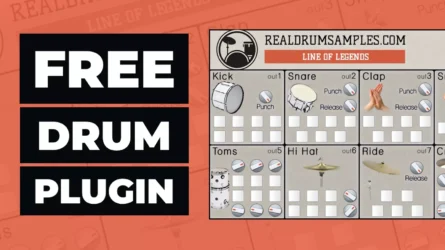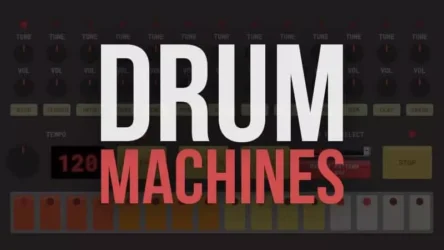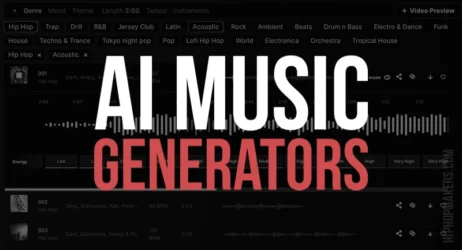This beginner’s guide will answer what is MIDI in music, how it is used, the different types of MIDI, and explain MIDI controllers.
- What is MIDI in Music Production
- What is MIDI Used For
- Types of MIDI
- What Are MIDI Controllers
- How Does MIDI Work
- What Are MIDI Files
- Is MIDI Still Used Today
- MIDI Overview
What is MIDI in Music Production?
MIDI stands for Musical Instrument Digital Interface. It is a protocol that enables computers, electronic instruments, and other musical devices to communicate with each other. It is not a musical instrument but just a digital interface for musical equipment.
The only thing that is required is an instrument that is equipped with MIDI ports.
It is important to note that MIDI data is different from audio recording as it doesn’t contain any sound as such.

Instead of that, it is limited to the performance information, which includes information about the various performance characteristics such as:
- What note is played and when
- Whether the keypresses change after the initial press
- Whether the pitch change while a key is played
- How hard someone presses the key
Using this information allows MIDI musicians to create performances that are rich in texture and sound.
MIDI controllers can be used to play virtual instruments like synthesizers and pianos.
Related: Best MIDI Keyboard Controllers
What is MIDI Used For?
The purpose of MIDI is to connect instrument devices with each other and to control one device using another device.
Previously to record any song or audio many things were required. For example, if any song was to be recorded then to add music to that song instruments such as guitar, violin, flute, etc were needed.
So the availability of all such instruments in the studio was important along with the artists who would play those instruments.
But nowadays because of MIDI, these things have become very easy. There are also MIDI keyboards available that look almost like Casio.
Using these MIDI instruments you can play the sound of many virtual instruments. In this, there are also many different modes through which the sound of the instruments can be changed.
In short, because of MIDI, editing and producing sound and music has become much easy nowadays.
Related: Free Online MIDI Editors & MIDI Players
What Are the Different Types of MIDI?
Here are some of the different types of MIDI devices and their role:
| MIDI Device: | Role: |
| Controllers | A MIDI device sends out MIDI messages. |
| Responders | A MIDI device that receives MIDI data and sends out audio signals. |
| Sequencers | A tool used to compose, record, and edit notes. |
| Interfaces | Part of the MIDI hardware. |
| Virtual Device | A virtual device in the computer. |
What Are MIDI Controllers?
In simple words, a MIDI controller is a device that controls another MIDI device. It is any hardware or software that helps generate and transmit MIDI data to MIDI-enabled devices.
It is important to note that musical sounds are generally not produced or created by the MIDI controllers themselves.
Instead, they have a certain type of interface that the performer presses, touches, strikes, or blows. This action then generates the MIDI data which is then transmitted to a MIDI-compatible sound module or synthesizer using a MIDI cable.
The sound module or the synthesizer produces the sound that is amplified by a loudspeaker.
For instance, the most commonly used MIDI controller is the electronic musical keyboard MIDI controller. So when the key is played, the MIDI controller sends MIDI data regarding how hard the note was played, its pitch, and its duration.
Uses Of MIDI Controllers:
- It is used to trigger musical sounds and play musical instruments.
- To control other MIDI-compatible devices.
How Does MIDI Work?
Data is transmitted over a cable, most commonly a MIDI cable, from one device to another.
The cable connects to MIDI ports on each device, and the MIDI ports are of three types as follows:
- In port: It receives incoming messages
- Outport: sends the messages
- Thru port: It is used in sending messages that one device receives directly into the in-port of another instrument.
It is also important to remember that MIDI signals travel in One Direction only.
The data flows out from the outport of a device to the in-port of another device. (However, not the other way around)
Remember that messages are sent in the form of binary digits, and each instrument can understand and respond to these messages.
To understand how MIDI works and the message flow occurs, let’s say that there is a keyboard synthesizer and you are interested in recording a sequence using the sounds that are in the synthesizer.
Now you connect your computer and your synthesizer so that they can start communicating using the MIDI protocol and start recording.
Whenever you play any notes on the synthesizer, all your physical actions that do on the instrument are transmitted to the computer sequencing software as MIDI messages which ultimately record the messages.
MIDI messages are brief numeric descriptions of action. So the keys you press, the knobs you turn, and all other such actions are encoded as MIDI messages.
What Are MIDI Files?
Files that have .MID or .MIDI file extensions are called MIDI Files.
Note that MIDI files are more compact than digital audio files. Generally, MIDI files can be 200 to 1,000 times smaller than CD-quality digital audio files.
MIDI files are smaller in size because, like the MP3 and WAVs, they don’t contain the actual audio data. Rather they contain information like what notes are played, when they are played, etc.
Since MIDI files are small, they have embedded web pages that load and play more quickly than their digital equivalents.
You can completely edit the MIDI data, even right down to the level of an individual note.
Related: 10 Best Websites for Free MIDI Files
Is MIDI Still Used Today?
MIDI is still used today all the time.
Before MIDI existed, the communication between electronic musical instruments was proprietary to each manufacturer.
But after MIDI came, it allowed more flexibility to music professionals by providing a common interface.
MIDI was primarily made to connect different hardware pieces together. In those early days, MIDI was usually used to connect two or three keyboards and the drum machine with the sequencer. Since it was a standard, it worked well with all brand names.
Nowadays, also MIDI is used, and some of the reasons are that MIDI files are small in size, MIDI is flexible, and MIDI can play sound fonts.
MIDI Overview
Musical Instrument Digital Interface is what MIDI stands for. The protocol enables computers, electronic instruments, and other musical instruments to communicate. Musicians use it as a digital interface for their musical equipment instead of a musical instrument.
The fascinating world of MIDI instruments and the music industry has made leaps and bounds over the decades, proving MIDI to be a powerful tool.
Understanding MIDI, from the MIDI message that’s transmitted when a key is pressed on a MIDI keyboard to the MIDI sequence that’s produced in a digital audio workstation (DAW), is crucial. It’s not just about pressing keys or twisting knobs; it’s about how those actions get translated into digital musical instruments that produce sound.
Understanding the intricacies of MIDI sequencers and their function within the realm of MIDI sequencing is also key.
These sequencers, including both hardware sequencer options and software instruments, allow you to arrange and edit a MIDI sequence.
Through this, you can create a song arrangement with multiple notes and note values, with the ability to control multiple MIDI channels and tracks from a single controller.
MIDI equipment such as MIDI synthesizers, drum machines, and other MIDI controllers are essential tools in our music production workflow.
They communicate via a MIDI connection, often a USB connection, sending and receiving MIDI notes to and from digital music hardware.
MIDI setups vary greatly in complexity, often integrating with a DAW and MIDI controller to form a complete digital music production ecosystem.
The beauty of the MIDI standard, including the general MIDI and the standard MIDI file, is in its universality.
A recorded MIDI can be played back through any MIDI interface, whether it be digital music devices or viable MIDI instruments. The MIDI note, MIDI event, or even an entire MIDI file can be transferred between MIDI interfaces with the use of MIDI cables.
The music industry has seen the introduction of many types of MIDI, including MIDI files for electronic keyboards, drum machines, and various digital instruments.
The universal aspect of MIDI allows a broad range of digital audio workstation software and hardware to work seamlessly with a variety of MIDI controllers.
In conclusion, MIDI, in all its forms, has revolutionized the way we create, record, and interact with music.
Whether it be through MIDI synthesizers, MIDI recording, or virtual instrument libraries, the ease and versatility of MIDI have made it an integral part of the modern music industry.
I hope you found this information on MIDI helpful, and hopefully, we answered what is MIDI in music production.
If we missed anything, please share it in the comments.




